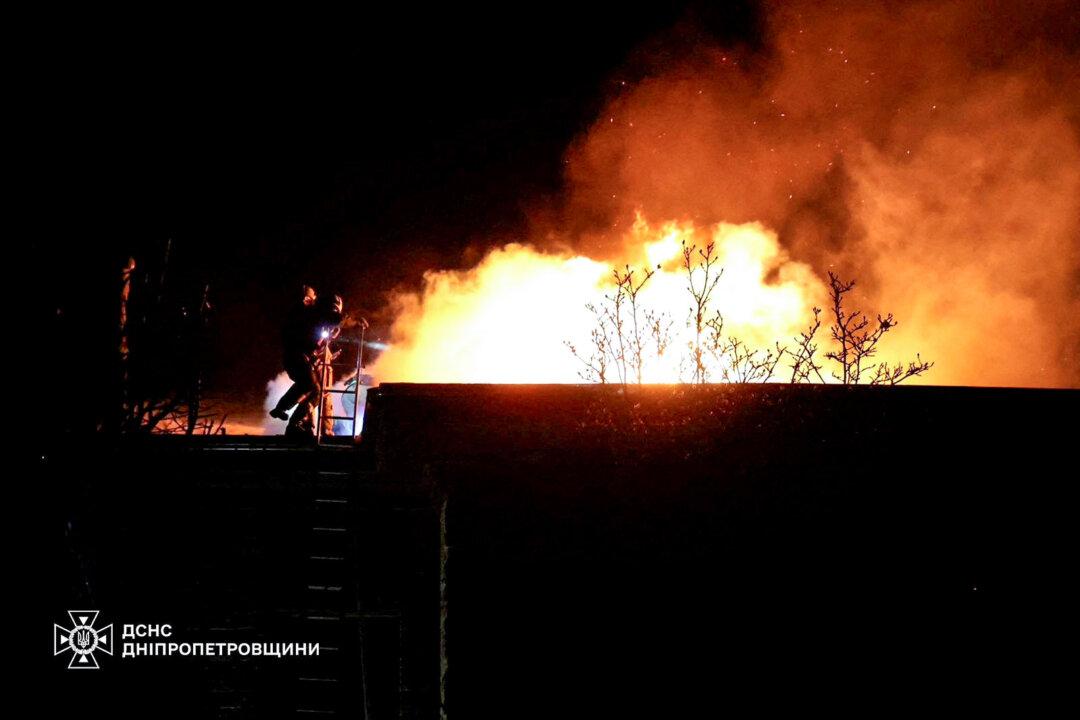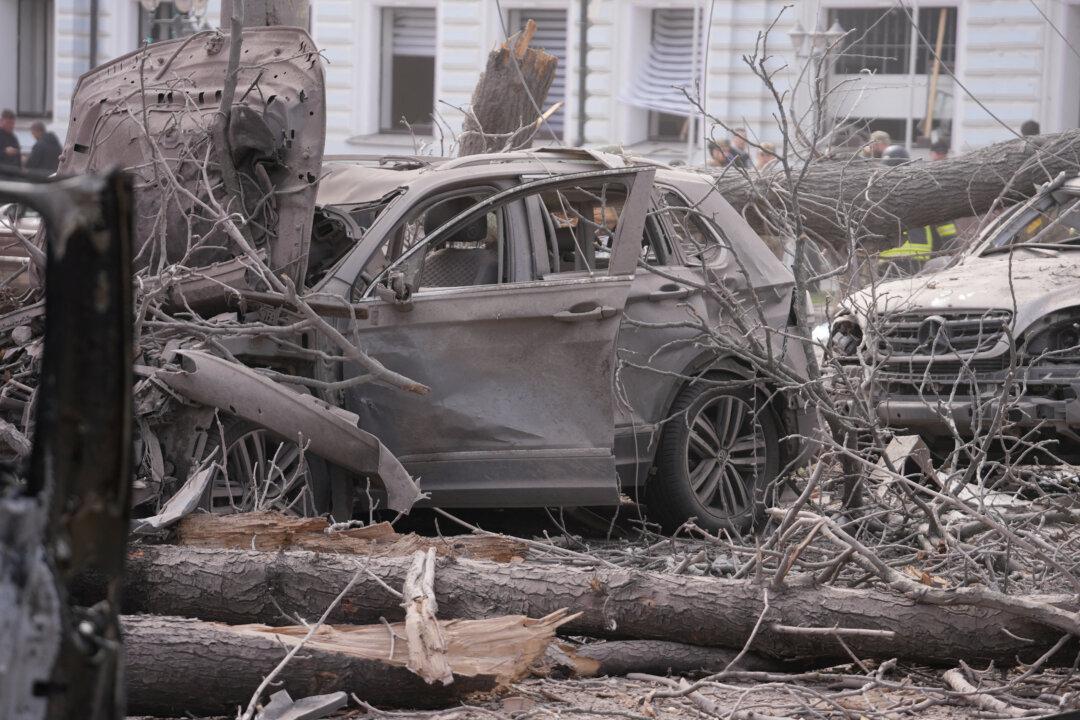The conflict in Ukraine has taken on “elements of a global nature,” Russian President Vladimir Putin said on Nov. 21 after Moscow fired an advanced hypersonic ballistic missile at Ukraine’s central-eastern city of Dnipro.
In a televised address, Putin said the ballistic missile attack was a response to “attacks by Western long-range weapons against [Russian] territory.”
Appearing to confirm earlier reports, Putin said Ukraine had fired six U.S.-made missiles into Russia’s Bryansk region on Nov. 19, followed by a second salvo on Nov. 21—with both U.S.- and UK-made missiles—into Russia’s Kursk region.
Moscow has repeatedly stated that Kyiv’s use of Western missiles—to hit targets in Russia—would be viewed as an act of war by the states providing long-range missile systems.
“The use of such weapons is not possible without the direct involvement of military experts from the manufacturing nations,” Putin said.
He added that the Nov. 21 attack on Kursk had caused some deaths and injuries—he did not give a figure—among Russian “perimeter security units and servicing staff.”
In response to the twin missile attacks, Russia’s military had successfully struck a Ukrainian defense-industrial facility in Dnipro with a “non-nuclear hypersonic ballistic missile,” the Russian leader said.
It remains unclear how much damage was caused by the ballistic missile strike on Dnipro, which has since been confirmed by U.S. and Ukrainian officials.
Pentagon spokeswoman Sabrina Singh later stated that Russia had used an “experimental intermediate-range ballistic missile” to hit targets in Dnipro.
Commenting on Putin’s remarks, Singh said the Pentagon was “going to take seriously the rhetoric coming out of Russia.”
“But our focus remains on arming Ukraine and supporting Ukraine [with] what it needs the most on the battlefield,” she told reporters on the evening of Nov. 21.
According to the spokeswoman, Moscow had provided Washington with advance warning about the impending ballistic missile strike on Dnipro.
Speaking to reporters on Nov. 22, Kremlin spokesman Dmitry Peskov said Moscow had informed the United States of the impending strike 30 minutes in advance.
He also confirmed that the Russian missile used to strike Dnipro was “not an intercontinental missile, but an intermediate-range one.”
“Thus, Russia is not obligated to issue notifications about its launch,” Peskov said.
Ukrainian President Volodymyr Zelenskyy called the ballistic missile strike on Dnipro a “clear and severe escalation.”

‘Mirror-Like’ Response
This week’s missile exchange comes amid a spate of media reports that the White House had lifted its longstanding ban on Kyiv’s use of U.S.-made missile systems to hit targets inside Russia.There has also been speculation that Paris and London may follow Washington’s lead by lifting similar bans on Ukraine’s use of French and British missile systems.
While the reports have not been officially confirmed, Moscow appears to be taking them seriously—especially after the strikes on Bryansk and Kursk.
In his address, Putin said the conflict in Ukraine “continues with the United States and its NATO allies previously announcing that they authorize the use of their long-range high-precision weapons for strikes inside the Russian Federation.”
He went on to assert Moscow’s right “to use our weapons against military facilities of those countries that allow [the use of] their weapons against our facilities.”
In the event of further “aggressive actions” by Kyiv and its Western supporters, Moscow will “respond decisively and in mirror-like manner,” Putin said.
On the same day, a Russian Foreign Ministry spokeswoman said a recently built U.S. missile defense base in northern Poland was among Moscow’s “priority targets for potential neutralization.”
“This can be achieved using a wide range of advanced weaponry,” she told reporters on Nov. 21.
Commenting on the remarks, a spokesman for Poland’s foreign ministry said the U.S. base, which is located near the Baltic coast, served a purely defensive function.
“Such threats [by Moscow] will certainly serve as an argument to strengthen Poland’s and NATO’s air defenses,” the spokesman said.

New Missile Crisis
U.S. officials, meanwhile, have thus far declined to confirm whether the White House has in fact lifted its ban on Kyiv’s use of U.S. missile systems to strike Russian territory.After the missile attack on Kursk, which reportedly used UK-made Storm Shadow missiles, British Defense Secretary John Healey likewise declined to comment.
While Kyiv has also remained relatively tight-lipped, Zelenskyy told reporters on Nov. 19 that Ukraine had “long-range capabilities” and planned to “use of all these.”
In his address, Putin said Kyiv’s use of advanced missile systems would “not affect” Russian offensive operations in Ukraine, claiming that Moscow’s forces were now advancing “along the entire line of contact.”
He also slammed Washington’s decision in 2019 to unilaterally withdraw from the Intermediate-Range Nuclear Forces (INF) Treaty.
Signed in 1987, the treaty prohibited the deployment of ground-based missile systems with ranges of more than 500 kilometers (310 miles).
In June, Moscow threatened to resume production of intermediate-range missiles that had been banned under the INF Treaty.
According to Putin, Russia is now developing “intermediate-range and shorter-range missiles” in response to alleged U.S. plans to deploy similar missiles “in Europe and the Asia-Pacific region.”
On Nov. 19, Putin greenlit a revision to Russia’s nuclear warfare doctrine, allowing for a nuclear response if Kyiv used advanced Western weapons to hit targets in Russia.
The Pentagon later said there were no indications that Russia was preparing to “use a nuclear weapon within Ukraine.”







